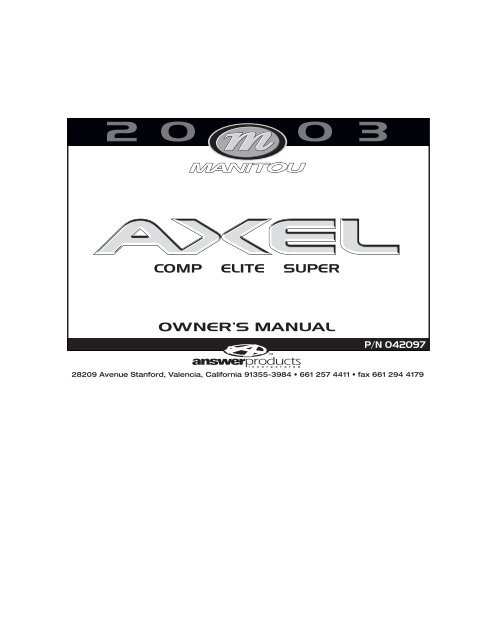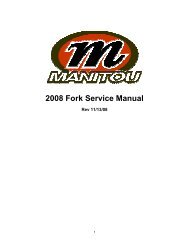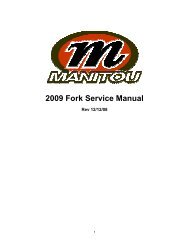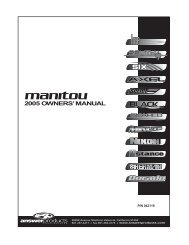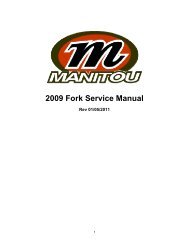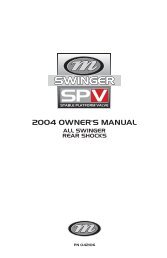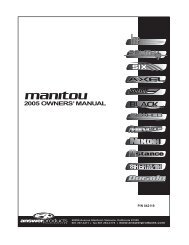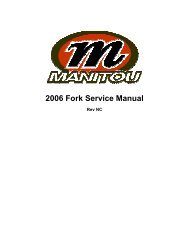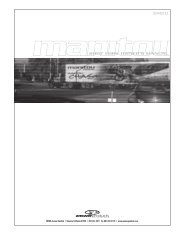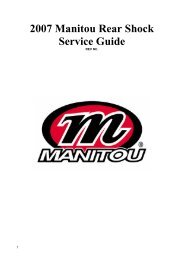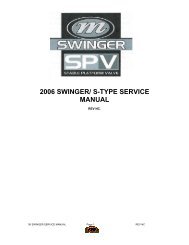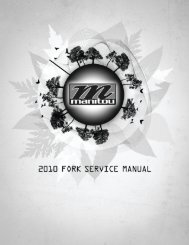2003 Axel Owners Manual.pdf - Manitou
2003 Axel Owners Manual.pdf - Manitou
2003 Axel Owners Manual.pdf - Manitou
Create successful ePaper yourself
Turn your PDF publications into a flip-book with our unique Google optimized e-Paper software.
.1. .2.<br />
.3. .4.<br />
.5. .6.<br />
.7. .8.
.9. .10.<br />
.11. .12.<br />
.13. .14.<br />
.15. .16. .17.
MANITOU SUSPENSION FORKS<br />
CONGRATULATIONS ON CHOOSING A <strong>2003</strong> MANITOU AXEL FORK. This<br />
<strong>Manitou</strong> AXEL fork is fully assembled and ready to be installed onto your bicycle.<br />
It comes equipped with a 1 1/8-inch threadless steerer tube, RA casting<br />
and is available with a V-brake-style hangerless arch. AXEL forks are also available<br />
in a disc brake only version. A handlebar-mounted reflector must be used<br />
for on-road use, which is not included with your fork.<br />
<strong>2003</strong> MANITOU AXEL FORK LINE<br />
AXEL COMP ..............80 OR 100 MM TRAVEL* / COIL SPRINGS / FLUID FLOW<br />
DAMPING / SINGLE CROWN / RA CASTING<br />
AXEL ELITE ...............80 OR 100 MM TRAVEL* / COIL SPRINGS / FLUID FLOW<br />
DAMPING / SINGLE CROWN / RA CASTING<br />
AXEL SUPER .............80 OR 100 MM TRAVEL* / COIL SPRINGS / FLUID FLOW<br />
DAMPING (REBOUND ADJUST) / SINGLE CROWN / RA<br />
CASTING / ALUMINUM STEERER TUBE<br />
*Preset from the factory, but changeable. See the Convertible Travel section in<br />
the Dealer Service Addendum for details.<br />
You can also download this manual at www.answerproducts.com.<br />
BICYCLING IS A HAZARDOUS ACTIVITY<br />
THAT REQUIRES THAT THE RIDER STAY<br />
IN CONTROL OF HIS OR HER BICYCLE AT ALL TIMES. READING THIS MANUAL<br />
ENTIRELY, AND PROPERLY MAINTAINING YOUR BICYCLE AND SUSPENSION<br />
FORK, WILL REDUCE THE POSSIBILITY OF INJURY OR POSSIBLE DEATH. PRIOR<br />
TO RIDING YOUR BICYCLE, YOU SHOULD INSPECT YOUR SUSPENSION FORK TO<br />
ENSURE THAT NO DAMAGE HAS OCCURRED DURING THE COURSE OF RIDING.<br />
DO NOT RIDE YOUR BICYCLE IF THE FORK SHOWS ANY SIGNS OF BENDING,<br />
CRACKING, CREAKING, LEAKING, OR IF IT IS MISSING ANY OF THE ORIGINALLY<br />
SUPPLIED COMPONENTS. ANY FALL FROM YOUR BICYCLE CAN RESULT IN<br />
SERIOUS INJURY OR EVEN DEATH. FOLLOWING THESE INSTRUCTIONS CAN<br />
HELP YOU REDUCE THE RISK OF BEING INJURED. IF YOU ARE A MODERATE OR<br />
AGGRESSIVE OFF-ROAD RIDER, OR RIDE AT LEAST THREE TIMES A WEEK OVER<br />
ROUGH TERRAIN, ANSWER RECOMMENDS RETURNING YOUR SUSPENSION<br />
FORK EVERY 2 YEARS FOR A THOROUGH INSPECTION AND UPDATE. TAKE<br />
YOUR FORK TO A MANITOU AUTHORIZED DEALER WHO CAN ARRANGE FOR<br />
SHIPMENT TO ANSWER PRODUCTS, OR YOU MAY CALL ANSWER AT (661) 257-<br />
4411 TO HAVE YOUR FORK SHIPPED DIRECTLY.<br />
IMPORTANT: The AXEL fork is an off-road fork, and as such, does<br />
not come with proper reflectors for on road use. Have your dealer or<br />
mechanic install proper reflectors to meet the Consumer Product Safety<br />
Commission’s (C.P.S.C.) Requirements for Bicycles if the fork is going to be<br />
used on public roads at any time. If you have questions regarding C.P.S.C.<br />
Standards, or would like to purchase a reflector bracket kit (Part #85-3674),<br />
contact your dealer.<br />
CONSUMER SAFETY INFORMATION<br />
1. Never remove or have the steerer tube or stanchions removed from the<br />
crown. The steerer tube and stanchions (inner legs) are press fit at the factory.<br />
Press fit inner legs have higher performance versus bolt-in inner legs, but<br />
can not be pressed out. Pressing them out will permanently damage the<br />
crown beyond repair and render it unsafe for any continued use.<br />
2. Never attempt to thread a threadless steerer tube. Cutting threads will weaken<br />
the steerer tube and cause an unsafe condition. The only safe thing to do<br />
is to obtain the proper crown/steerer from your dealer, or contact Answer<br />
Customer Service at (661) 257-4411.<br />
3. Any other alteration or modification to your fork should be considered<br />
unsafe. Contact Answer Customer Service prior to modifying your fork in any<br />
way for safety information.<br />
4. Do not use the AXEL fork if any parts are broken, bent, cracked, or you suspect<br />
may be damaged. Contact your dealer or Answer Warranty (661) 257-<br />
4411 if you have any questions concerning the integrity or condition of your<br />
fork.<br />
5. Answer Products recommends that you inspect your fork before every ride<br />
for wear and damage. Inspect the crown, inner legs, outer legs dropout and<br />
brake arch areas for cracks or damage.<br />
WARRANTY INFORMATION<br />
Any Answer Products fork found by the factory to be defective in materials<br />
and/or workmanship within one year from the date of purchase (or two years in<br />
EU countries) will be repaired or replaced at the option of the manufacturer, free<br />
of charge, when received at the factory with proof of purchase, freight prepaid.<br />
This warranty does not cover breakage, bending, or damage that may result<br />
from crashes or falls. This warranty does not cover any fork that has been subject<br />
to misuse or whose serial number has been altered, defaced or removed.<br />
This warranty does not cover paint damage. Any modifications made by the<br />
user will render the warranty null and void. This warranty is expressly in lieu of<br />
all other warranties, and any implied are limited in duration to the same duration<br />
as the expressed warranty herein. Answer Products shall not be liable for<br />
any incidental or consequential damages. If for any reason warranty work is<br />
necessary, return the fork to the place of purchase. At that time, instructions for<br />
repair, return, or replacement shall be given. Customers in countries other than<br />
USA should contact their dealer or local distributor.<br />
INSTALLATION INSTRUCTIONS<br />
Ensure that the proper steerer tube has been delivered on your <strong>Manitou</strong> AXEL.<br />
The steerer tube may need to be cut to length to fit your bicycle head tube. If<br />
you are not familiar with this procedure, or do not have the proper tools to cut<br />
the steerer tube, it is recommended that you seek a dealer with a qualified bicycle<br />
mechanic to perform installation.<br />
THE STEERER TUBE AND STANCHIONS (INNER LEGS)<br />
ARE A ONE TIME PRECISION PRESS FIT AT THE FACTO-<br />
RY AND CAN NOT BE REMOVED FROM THE CROWN. REPLACEMENT OF THE<br />
ENTIRE CROWN/STEERER ASSEMBLY MUST BE DONE TO CHANGE STEERER<br />
TUBE LENGTHS OR DIAMETERS. REMOVING AND REPLACING THE STEERER<br />
TUBE OR STANCHIONS WILL RESULT IN AN UNSAFE CONDITION AND SHOULD<br />
NEVER BE DONE.<br />
BREAK-IN<br />
Your new fork is designed to break-in during your first few rides (about 20<br />
hours total riding time). Prior to break-in, you may notice your fork binds<br />
slightly and feels notchy. Following the break-in period, your fork will feel much<br />
smoother and will react to bumps much better than when you first put it on<br />
your bike. After 20 hours, you may want to recheck your rebound and preload<br />
adjustments (when applicable) to fine tune the fork completely. Between services<br />
on your <strong>Manitou</strong> fork, all you must do is lubricate your fork as needed with<br />
<strong>Manitou</strong> Prep M (part number 85-3810 for the lube and 85-3812 for the injector<br />
gun) via the Microlube grease ports located on the back of the fork legs.<br />
FORK INSTALLATION<br />
1. Remove the old fork from your bicycle.<br />
2. Measure and cut the steerer tube to fit your bicycle head tube. You can use<br />
your old fork as a guide for cutting the steerer tube length.<br />
3. Remove the headset crown race from the old fork and press onto the<br />
<strong>Manitou</strong> AXEL steerer tube until the race is seated over the crown.<br />
4. Clean and grease the headset bearings and races.<br />
5. Install the lower bearings (if applicable) on the fork crown race.<br />
6. Insert the steerer tube into the head tube of the frame.<br />
7. Install the upper bearings, stem spacers, and stem.<br />
8. Install the stem cap and bolt. Tighten the bolt to headset manufacturer’s<br />
specifications.<br />
9. Install the handlebars to desired height and the torque stem pinch screws<br />
or stem clamping system to manufacturer’s specifications.<br />
10. Install the brakes and adjust per the manufacturer’s instructions.<br />
11. For all AXEL forks, adjust the front wheel quick release to clear the 0.334"<br />
(8.5 mm) thick secondary catch dropout. The quick release must be tightened<br />
after it is properly seated into the dropout counter bores to manufacturer’s<br />
specifications. Ensure that there is adequate thread engagement (4<br />
or more threads with the release adjusted to lock).<br />
NOTE: <strong>2003</strong> <strong>Manitou</strong> AXEL forks are equipped with a secondary catch dropout<br />
to retain the wheel in the fork in the event the quick release comes loose.<br />
WHEN INSTALLING THE WHEEL OR A NEW TIRE, CHECK<br />
TO MAKE SURE THE FORK ACHIEVES MINIMUM TIRE<br />
CLEARANCE. MEASURE FROM THE HIGHEST POINT ON THE TIRE TO THE BOT-<br />
TOM OF THE BRAKE ARCH. THIS MEASUREMENT SHOULD BE 10 MM. (FIGURE<br />
1)<br />
IMPORTANT: The <strong>Manitou</strong> AXEL fork should not be used if any parts<br />
appear to be or are damaged. Contact your local dealer or Answer Products<br />
for replacement parts.
MAINTENANCE<br />
IMPORTANT: Use of fork boots is required to keep your <strong>Manitou</strong> AXEL fork<br />
performing well and the warranty in effect. Use of this fork without boots will<br />
shorten the life of the fork, decrease the time between maintenance intervals,<br />
reduce the performance and void the warranty.<br />
IMPORTANT: When lubricating the fork with grease through the grease<br />
ports, it is important to note that grease is being forced between the upper<br />
and lower bushings. If the area is overfilled, the grease may force the upper<br />
bushing and dust seal out. You should only insert grease to the level at<br />
which stiction (stickiness when you compress the fork) is no longer felt.<br />
IMPORTANT: Before every ride you should:<br />
1. Ensure that quick release skewers are properly adjusted and tight.<br />
2. Wipe the inner legs and clean and check entire fork for any obvious damage.<br />
3. Check the headset for proper adjustment.<br />
4. Ensure that the front brake cable is properly routed and check brake<br />
adjustment.<br />
CHECKING OIL LEVEL<br />
IMPORTANT: Setting the proper oil level in your Fluid Flow damped fork is<br />
critical. Fluid Flow damping is located in the right leg of your <strong>Manitou</strong> AXEL<br />
fork. Not enough oil will allow foaming and reduce the performance. Too<br />
much oil will restrict travel and may cause damage to the system and create<br />
an unsafe riding condition. Finish reading this entire section prior to altering<br />
the oil level.<br />
To check the oil level on the <strong>Manitou</strong> AXEL, remove the compression assembly<br />
located in the top of the right leg (as you are looking at the fork from the rider’s<br />
position). Leave the left side spring stack in place to keep the fork fully extended.<br />
Use a tape measure or “dip stick” to measure from the top of the fork<br />
crown down to where the oil sits (Figure 2). The oil level for the <strong>Manitou</strong> AXEL<br />
should be per following table.<br />
Fork Model<br />
Oil Level<br />
<strong>Manitou</strong> AXEL 115-125 mm (4.5-4.9”)<br />
NOTE: Use SAE 5WT fork oil suspension fluid only.<br />
If you have any questions regarding your <strong>2003</strong> <strong>Manitou</strong> AXEL suspension fork,<br />
contact the Answer Products Customer Service Department at (661) 257-4411.<br />
You can also log on to www.answerproducts.com and download this manual or<br />
see detailed instructions on how to service your suspension fork.<br />
Thank you again for choosing a <strong>2003</strong> <strong>Manitou</strong> AXEL suspension fork.<br />
AXEL DEALER<br />
SERVICE ADDENDUM<br />
This section is designed to help you tune and maintain your <strong>Manitou</strong><br />
suspension fork.<br />
MEASURING SAG To measure sag, you’ll need a tape measure,<br />
a pencil, a piece of paper and a helper.<br />
1. Measure the distance from the front axle’s centerline to the bottom of<br />
the upper crown when no one’s sitting on the bike and write this distance<br />
down. (Remember the exact locations of the two points because<br />
you’ll need to use them later.)<br />
2. Have the rider sit on the bike and measure the distance between the<br />
same two points as in step one. It’s important to be in the normal riding<br />
position (weight centered) with the rider’s feet on the pedals.<br />
3. Subtract the second measurement from the first. The resulting measurement<br />
is the static sag or ride height.<br />
SAG MEASUREMENT<br />
Fork Travel<br />
Sag<br />
80 mm 12-16 mm<br />
100 mm 18-24 mm<br />
TRAVEL MEASUREMENT To determine which travel your AXEL<br />
fork is in, simply measure the distance from the top of the seal area on<br />
the lowers (or the bottom of the fork boot) to the bottom of the crown<br />
(Figure 3).<br />
Fork Travel<br />
Seal to Crown Measurement<br />
80 mm Around 4.3 inches or 109 mm<br />
100 mm Around 5.2 inches or 130 mm<br />
RECOMMENDED SPRINGS<br />
AXEL Rider Weight Recommended Spring Kit<br />
100-150 lbs. Soft ride kit (Part #85-4826)<br />
Standard Set-up 150-170 lbs. Medium ride kit (Part #85-4827)<br />
170 plus lbs. Firm ride kit (Part #85-4828)<br />
CHANGING SPRINGS AND/OR MCU’S Once you have checked<br />
sag, you can either preload the spring via the cap on top of the left hand<br />
leg, or even better, make spring changes to accommodate for your riding<br />
style and weight.<br />
1. Start by removing the preload adjuster by unscrewing the 2 mm hex<br />
bolt on the adjuster knob. A 20 mm socket will be necessary with the<br />
AXEL. Remember: The springs are housed only in the left leg on <strong>2003</strong><br />
<strong>Manitou</strong> suspension forks. (Figure 4)<br />
2. With the adjuster assembly removed, the spring stack is now accessible.<br />
(Figure 5)<br />
3. Select the appropriate coil spring for your weight and riding style<br />
(refer to the above spring chart for recommended rates).<br />
4. Apply a liberal amount of grease to the outside surface of the new coil<br />
spring (Figure 6). We recommend any thick grease (not light greases<br />
like Prep M). Install the new spring stack.<br />
5. Reinstall the preload adjuster knob and adjuster assembly, taking<br />
care not to cross-thread the adjuster assembly. It should be snug<br />
tightened with a wrench. (Figure 7)<br />
CONVERTIBLE TRAVEL<br />
1. Changing the travel from 80 to 100 millimeters or vice-versa requires<br />
the removal of the lower legs.<br />
2. Remove the rebound adjuster knob with a 2 mm hex wrench (AXEL<br />
Elite and Super models only). (Figure 8)<br />
3. Next unthread (clockwise to loosen) the 8 mm and 4 mm bolts on the<br />
bottom of the fork and pull the lowers free from the uppers. Unscrew<br />
the cap on the bottom of the right leg (as seen from the rider’s position).<br />
This will expose the clip that is used to adjust the travel.<br />
(Figure 9)<br />
4. Remove the clip and insert it into the upper position (above the rod<br />
flange) for 100 millimeters of travel or the lower position (below the<br />
rod flange) for 80 millimeters of travel. (Figure 10)<br />
5. Reassemble fork.<br />
MAINTENANCE AND SERVICE – INTRODUCTION When servicing<br />
the fork, take the time to inspect all parts for excessive wear or<br />
damage. There are basically four aspects of a fork that will require<br />
attention: the stanchions (inner legs), the bushings in the outer legs,<br />
the spring stack and the damping fluid. Inspecting any of these parts<br />
requires disassembly of the fork. Pay close attention to the bushings,<br />
which can be damaged by contamination in severe conditions. Replace<br />
any worn or damaged parts that are discovered.<br />
CHANGING THE OIL IN YOUR FORK Changing the oil in your<br />
damped fork is very easy to do. All of the damping systems, FFD, TPC<br />
and TPC Plus, house the oil in the right leg.<br />
1. Remove the cap from the top of the right fork leg<br />
(1 1 /16" socket). (Figure 11)<br />
2. Rock the compression damping assembly back and forth slightly as<br />
you pull up on it to remove it.
3. Pour the old oil out of the fork. (Figure 12)<br />
4. Stroke the fork up and down to remove the oil that settles beneath<br />
the rebound piston. Pour this oil out as well. (Figure 13)<br />
5. Add oil to the level shown in the Checking Oil Level section of this<br />
manual. (Figure 14) Cover the leg opening and stroke the fork up and<br />
down a few times before the final measurement is taken to ensure<br />
that oil has flowed beneath the rebound piston again.<br />
FORK DISASSEMBLY Disassembly of your AXEL fork is necessary<br />
to provide the proper service of your fork. To do this:<br />
1. Remove the adjustment knob on the bottom of your fork with a 2 mm<br />
Allen wrench.<br />
2. Remove the bolts from the bottom of the fork leg with 4 and 8 mm<br />
wrenches and set aside. (Figure 15)<br />
3. You can now pull apart the fork, removing the casting from<br />
crown/steerer assembly. (Figure 16)<br />
4. Wipe clean the inside of the fork casting, stanchion tubes, fork boots,<br />
and crown. At the same time you do this, do a complete inspection on<br />
the fork. (Figure 17)<br />
MICROLUBE All you need is a Microlube lubricant gun<br />
(part #85-3812) and <strong>Manitou</strong>’s Prep M suspension fork lubricant (part<br />
#85-3810). Brush any dirt from the grease ports and inset the grease<br />
gun into the small fitting located at the back of the fork and squeeze a<br />
few times. Continue injecting grease and push the fork up and down<br />
until stiction is eliminated.<br />
SERVICE SCHEDULE –<br />
Suggested Service for <strong>Manitou</strong> forks<br />
NORMAL CONDITIONS – Short/Infrequent Rides<br />
• Lube fork as needed with Prep M lubricant via Microlube ports.<br />
• Disassemble, clean and lubricate fork every 4-5 months.<br />
• Lubricate spring stack as needed.<br />
• Service FFD by changing damping fluid every year.<br />
NORMAL CONDITIONS – Long/Frequent Rides<br />
• Lube fork as needed with Prep M lubricant via Microlube ports.<br />
• Disassemble, clean and lubricate fork every 10-14 weeks.<br />
• Lubricate spring stack as needed.<br />
• Service FFD by changing damping fluid every 6 months.<br />
SEVERE CONDITIONS (MUD, RAIN, SNOW, EXTREME DUST) –<br />
Short/Infrequent Rides<br />
• Lube fork as needed with Prep M lubricant via Microlube ports.<br />
• Disassemble, clean and lubricate fork every 6-8 weeks.<br />
• Lubricate spring stack as needed.<br />
• Service FFD by changing damping fluid every year.<br />
SEVERE CONDITIONS (MUD, RAIN, SNOW, EXTREME DUST) –<br />
Long/Frequent Rides<br />
• Lube fork as needed with Prep M lubricant via Microlube ports<br />
• Disassemble, clean and lubricate fork every 4-6 weeks.<br />
• Lubricate spring stack as needed.<br />
• Service FFD by changing damping fluid every 6 months.


